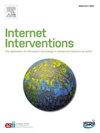用户参与为经历过技术辅助性虐待的年轻人设计的数字健康干预(i-Minds试验)
IF 4.1
2区 医学
Q1 HEALTH CARE SCIENCES & SERVICES
Internet Interventions-The Application of Information Technology in Mental and Behavioural Health
Pub Date : 2025-07-08
DOI:10.1016/j.invent.2025.100858
引用次数: 0
摘要
技术辅助性虐待(TASA)主要涉及性图像的制作和未经同意的分享;然而,对经历过TASA的年轻人(YP)的循证支持很少。数字卫生干预措施(DHIs)有可能增加获得支持的机会,并以熟悉的格式向青少年计划提供及时的治疗投入。然而,描述与DHIs接触的研究尚处于起步阶段。我们的目标是描述使用i-Minds应用程序的YP人员的参与模式。方法i-Minds应用程序是为经历过TASA的YP人员共同设计的基于心理的DHI。在为期6周的干预期内,使用Matomo分析软件收集使用数据,并根据amuse框架进行分析。41名参与者使用了该应用程序。其中,95%的人完成了入门必修模块,近一半的人完成了剩下的三个模块。应用粘性的平均持续时间为33天。大多数参与者在工作日的下午使用这款应用。人口统计变量(即性别与出生时的性别不匹配/不愿透露)和较高的基线临床严重程度与较高的应用粘性相关。结论参与者表现出较高的模块完整性和参与时间,表明其具有实际应用的潜力。确定了参与的潜在参与者水平预测因素,如性别认同和与TASA相关的创伤应激和情绪困扰的严重程度。实现令人满意的DHIs参与是具有挑战性的,但对于提供有效的干预措施是必要的。未来的研究应该探索参与者层面的参与预测因素,以告知现实世界中不同样本的DHIs使用情况。本文章由计算机程序翻译,如有差异,请以英文原文为准。
User engagement in a digital health intervention designed for young people who have experienced technology-assisted sexual abuse (i-Minds trial)
Background
Technology-assisted sexual abuse (TASA) mostly involves the production and non-consensual sharing of sexual images; however, evidence-based support for young people (YP) who have experienced TASA is scant. Digital Health Interventions (DHIs) have the potential to increase access to support and provide timely therapeutic input in a familiar format to YP. However, studies describing engagement with DHIs is nascent. Our objective is to describe engagement patterns for YP people who used the i-Minds app.
Methods
The i-Minds app is a co-designed mentalisation-based DHI for YP who have experienced TASA. Usage data was collected during the 6-week intervention window using Matomo analytics software and analysed according to the AMUsED framework.
Results
Forty-one participants were onboarded to the app. Of these, 95 % completed the introductory mandatory module, and nearly half completed the remaining three modules. Median duration of app engagement was 33 days. Most participants used the app on weekdays in the afternoon. Demographic variables, namely gender not matching with sex assigned at birth/prefer not to disclose and higher baseline clinical severity were associated with higher app engagement.
Conclusions
Participants showed high module completeness and engagement duration, suggesting the potential for real-world use. Potential participant-level predictors of engagement, such as gender identity and severity of TASA related traumatic stress and emotional distress, were identified. Achieving satisfactory engagement in DHIs is challenging yet necessary for delivering effective interventions. Future studies should explore participant-level predictors of engagement to inform real-world use of DHIs with a diverse sample.
求助全文
通过发布文献求助,成功后即可免费获取论文全文。
去求助
来源期刊

Internet Interventions-The Application of Information Technology in Mental and Behavioural Health
Medicine-Health Informatics
CiteScore
6.50
自引率
9.30%
发文量
94
审稿时长
6 weeks
期刊介绍:
Official Journal of the European Society for Research on Internet Interventions (ESRII) and the International Society for Research on Internet Interventions (ISRII).
The aim of Internet Interventions is to publish scientific, peer-reviewed, high-impact research on Internet interventions and related areas.
Internet Interventions welcomes papers on the following subjects:
• Intervention studies targeting the promotion of mental health and featuring the Internet and/or technologies using the Internet as an underlying technology, e.g. computers, smartphone devices, tablets, sensors
• Implementation and dissemination of Internet interventions
• Integration of Internet interventions into existing systems of care
• Descriptions of development and deployment infrastructures
• Internet intervention methodology and theory papers
• Internet-based epidemiology
• Descriptions of new Internet-based technologies and experiments with clinical applications
• Economics of internet interventions (cost-effectiveness)
• Health care policy and Internet interventions
• The role of culture in Internet intervention
• Internet psychometrics
• Ethical issues pertaining to Internet interventions and measurements
• Human-computer interaction and usability research with clinical implications
• Systematic reviews and meta-analysis on Internet interventions
 求助内容:
求助内容: 应助结果提醒方式:
应助结果提醒方式:


